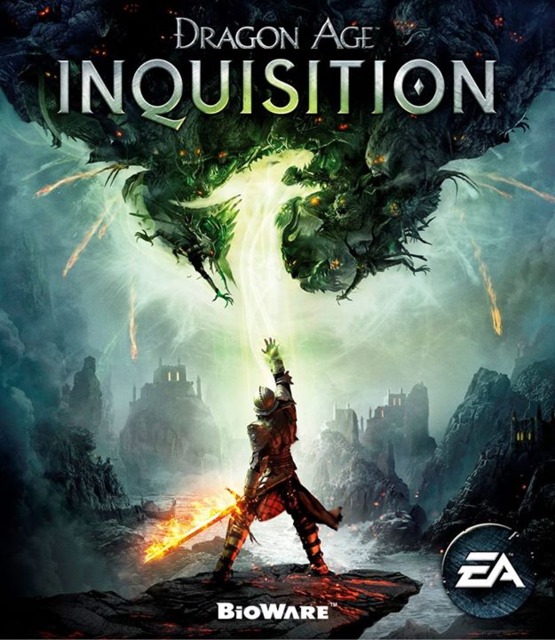A feast for fans of the genre
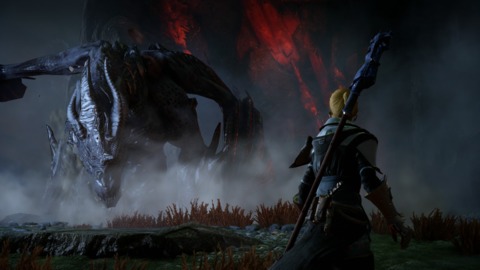
As my party stands above a slumbering dragon that has found it’s home in a decrepit pantheon just below us, Iron Bull suddenly questions Cassandra about her feelings towards another party member. Cassandra doesn’t have anything flattering to say and Bull turns to me for an opinion. With a click of the stick I engage this optional conversation and let them know they shouldn’t discuss someone when they aren’t even here to defend themselves. As I buff us all with barriers and jump down to confront one of the last dragons in Thedas I hear Iron Bull gruffly remark “..not that he would anyway.” This type of ambient party banter easily defines Bioware's latest entry in the Dragon Age franchise - dynamic, character driven and uniquely hand crafted.
Dragon Age: Inquisition is the third game in a series that has seen some dramatic changes with each new iteration. While this latest gambit is nothing like the two preceding it, Bioware has managed to find a happy medium between modern gameplay and classic ideas.
The story is deeply entrenched in lore and in no small way connected to the events of the previous games. During a summit called between the much estranged mages and templars, a sudden explosion rends the sky open and takes the life of a holy figure. At the epicenter of the explosion, among the hundreds of dead the only survivor is you, now marked with a mysterious brand that oddly resonates with the newly formed rift in the sky threatening to consume the world. A demon spewing hole above your head is a predicament all on it’s own and the death of a saint in a land already torn by political turmoil doesn’t help things either. Thus the Inquisition is born - an ancient order that forms whenever needed and welcomes all who join equally. A temporary alliance of sorts with the sole purpose of overcoming a greater evil, disbanding when the need is no longer present. And who better to lead it than the one person who now has the power the close the rifts literally in the palm of their hand? As the Inquisitor you need to gather allies and build your forces to overcome this current crisis and maybe get a little bit of that classic Bioware lovin’ going on the side.
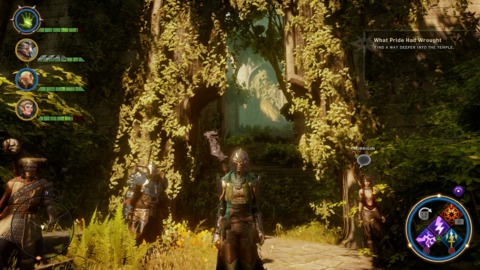
A game born of two worlds, Inquisition is at once oldschool enough to drive away more casual players, but a little too modern to bring in those they’ve lost along the way. There is a plethora of systems present that the game never truly explains all that well ranging from the complex crafting to the esoteric combo system. In fact the biggest shortcoming of Inquisition is it’s inability to not only explain things clearly, but direct the player in this dense new world. At it’s heart this is a classic role playing game of progressing through the main questline while attaining new allies, gathering exciting new loot and leveling up along the way. There are three primary classes to initially choose from: Warrior, Rogue, Mage and each has branching ability trees along with specialized subclasses attainable at higher levels. You can be a sword and shield knight able to withstand the toughest blows or a two handed warrior dealing massive damage. There are tons of options with unique skills and passive buffs that all feel significant without any filler stopgaps in the form of 5% resistance to poison damage along the skill trees. In a juxtaposition of old and new, you level up your character and choose their abilities, but the modern flip is that you no longer distribute stat points yourself as those are doled out according to which abilities you’ve chosen to “purchase” with your skill points. This is a simplified system that lets the player craft their heroes in their own unique ways without the micromanagment of stats. Along your journey you will get the opportunity to apprehend and judge those found guilty by the inqusition, deciding their fate from death to induction into your ranks. While the game does offer choice, for an RPG there aren’t that many significant options at your disposal. There are several key decisions that strongly impact your gameworld as a whole, but overall this is a very focused experience that leans heavier on character building than the main story at hand.
Combat is probably going to be the most divisive aspect of the entire game. Many fans of Origins lamented the loss of a tactical view. While this option does make a return in Inquisition it is clunky, with the camera awkwardly pulled in way too close, and of limited necessity on the normal difficulty level. What Bioware giveth, it also taketh away, and gone are limitless supplies of healing potions that one would normally stock up on before any major encounter. Inquisition adopts the Mass Effect style of having a static amount of healing flasks that can only be replenished at camps or supply crates that are usually positioned before boss fights or in the middle of particularly lengthy story missions. When out and about players will have to make do with only 8 healing potions that can be upgraded to a maximum of 12. On the flipside unlike past games party members can be revived in the middle of combat, once again much like Mass Effect, and should you be reduced to only one hero standing you can always make a run for it as breaking the active combat range will instantly revive your team around you. While on paper this limited healing system may sound terrible, in reality it only makes the early parts of the game challenging until you level and gear up, obtaining new abilities that mitigate damage, revive party members and in the case of one subclass even heal those around you. It creates a much more dynamic feeling game with a lot more consequence to each encounter.
The fighting itself feels awkward at first but grows on you with time to something closely resembling control. Much like the tactical view, when you enter active combat the game adopts yet another awkward camera angle that goes over the shoulder but for some reason drops all the way down to the ground. Fighting takes on a more active approach reminiscent of typical third person melee and when in the thick of it is very flashy with particle effects and colorful magic flying all around you, even if the actual mechanics behind it are a lot less involving. Your active abilities map to the face buttons and require either stamina or mana to power, both of which build up through regular attacks. Playing a mage can essentially boil down to holding down the trigger while babysitting cooldowns on all your spells. That is of course if you’re content with doing the very bare minimum, which at most times will probably get you through the fight albeit a few precious potions poorer. Since you can actively jump between all party members it’s much more engaging to set up opportunities for combo attacks and cross-class actions such as freezing an enemy with a mage and then shattering them with a powerful warrior combo detonator. Granted, at it’s most tactical the combat in Inquisition isn’t going to set the world on fire, but at the same time it can be as dull or as involved as the player makes it out to be.
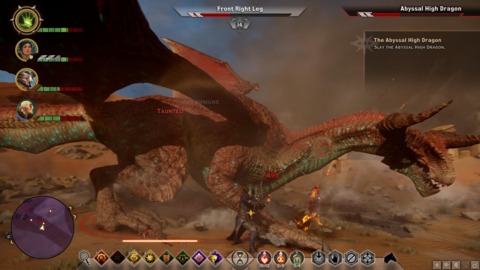
Outside of brawling the world of Thedas is vast and littered with secondary objectives. Closing rifts, completing favors for party members (like destroying red lyrium deposits for Varric), exploring, dungeons and discovering landmarks are all mainstays of your travels. Inquisition doesn’t offer a fully interconnected free roaming landmass, but rather settles on sizeable, isolated areas, to which you travel from an overmap before exploring them at your leisure. Ultimately this turns out to be brilliant design as having individual zones trims the fat of pointless transition areas and lets each place have have it’s own distinctly unique identity. From the sprawling woodlands of the Hinterlands, to the arid deserts of the Hissing Wastes, each area has a unique theme, enemy subset and color template, offering wonderfully hand crafted level design and some really stunning vistas. Each area also has it’s own unique storyline with specific quests along the way that help flesh it out and give it meaning. Much like the combat, the onus is on the player as to how much enjoyment they will get out of the many side quests present in each zone. If you mash your way past all the text (and there is quite a bit of reading to be done here) in order to get to the next checkpoint on the map, then a lot of what you experience will be simply running from point A to B and killing some enemies along the way with no rhyme or reason. Yet if you take the time to read through the mission backstories you can experience small "quests" like following a note of a young couple agreeing to meet for a romantic picnic. As you approach a quiet meadow with a basket and wine set out on a blanket among the grass, spiders descend from the foliage above in an ambush. Upon clearing them all out you discover an engagement ring on one of the spider corpses, and your mind pieces together the events that must have befallen these young lovers. It’s no Hemingway but if you invest yourself in the world these smaller excursions can be rewarding experiences. The most exciting of all the activities is the hunting of dragons. These ancient beasts are scattered around the world and offer challenging battles that should be approached only when you get some dozen or so levels under your belt. With great risks come great rewards and one of the many draws of fighting dragons apart from the spectacle are the unique items they drop along with very rare, high end crafting materials.
All this exploration ties in with the robust crafting and potion upgrade system. Going from zone to zone you collect different minerals, leather and herbs which all partake in one of the greater timesinks of the game. If you take a guilty pleasure in playing dress up with your characters then Inquisition does not disappoint. There are dozens upon dozens of crafting schematics for you to discover and each piece of armor or weapon is made up from several different parts that can be mixed and matched to your hearts content. Craft a sleek leather outfit for your rogue, or an armored variant, or mix the two by crafting plated arms and leather legs. Additionally each piece of armor appears differently on each of your party members. Vivienne’s aristocratic mage robes feature a regal look while Solas, the wandering apostate, dons more travelled looking gear. Different ingredients offer different color and texture combinations that all ultimately contribute to specific stat boosts. It’s a shame that the systems for crafting are all a bit clunky. There are tons of menu’s to sift through and for whatever reason you cannot equip items when customizing them, forcing you to go in and out of the inventory screen constantly. The fact that, at least on the PS4 version, your characters take a good 5 seconds to load up each time you open the inventory screen doesn’t help things either. Those small issues aside, for all customization enthusiasts, Inquisition is pure heaven and I had personally lost nearly entire hours mixing and matching all the little pieces to make sure my Inquisitor and the rest of their team were saving the world, in style.
The second more hands off time sink is the war table, a tactical map from which you launch full scale story missions, or small secondary excursions that yield accessories for your base, equipment, or sometimes even new agents that can be recruited to aid the inquisition. Primary missions require “power” to launch, which you gain from closing rifts in the wild or from performing secondary missions. These smaller scale quests can be assigned to one of your trusted advisors and have real time countdowns to their completion - some taking several hours to complete. The war table is a strange addition to the game, and one that would ironically benefit from an external phone app which it sadly does not have. At times you tie up all three of your advisors with side content for hours on end and can’t get to more important tasks at hand. Ultimately one can get by without interacting with the war table too much, but you’d be missing out on a lot of customization items and potential new alliances that help reduce these lengthy cooldowns.
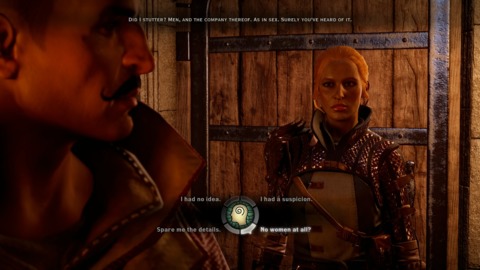
At the heart of everything are your trusted battle companions. In classic Bioware style, your team takes center stage and it’s the interactions between them that really make the game stand out. You will meet interesting new characters along the way: like the Qunari mercenary leader Iron Bull who has a no nonsense approach to life and is easily one of the most likeable companions to tag along with - or the childlike Sera, an elf street urchin always looking to get into some mischief. In a smart move each character you meet, nine in all, represent one of the classes available in the game. All have interesting backstories and character specific “loyalty” missions that help flesh out their past and shed a little light on what makes them who they are in the present. By far the most enjoyable aspect of these companions is the idle banter between them as you roam about the world. Sera doesn’t get along with Vivienne and Cassandra has a bad past with Varric and Iron Bull just wants to murder things. Party members will also comment on current events, completed quests or even the immediate area if the situation calls for it - for instance Cole provides a very unique perspective during a particularly fun “haunted house” side quest. The fact that NPC’s are talking to one another seems like such a small thing, but it really adds a lot of authenticity to the gameworld and helps the AI party members feel like actual companions that you might care about. Romance options are there if you wish to pursue them with some surprising combinations all in all. Surprisingly this time Bioware went all in with some graphic love making scenes featuring full frontal, video game nudity.
Dragon Age: Inquisition is an excellent game to really lose yourself in with some truly mesmerizing world design. Although not always consistent in it’s presentation you’re able to forgive the minor hiccups here and there as it really is a great looking game. Voice acting is superb as per Bioware standard with a notable performance by Freddie Prince Jr. who you would never recognize as the free caring Iron Bull. Small design decisions like the clunky menu’s and sometimes awkward combat keep Inquisition from realizing it’s full potential, but it also paves the way for a really great future. Any true fan of role playing games should feel right at home in Inquisition with wonderful variety, great characters and just an overall immersive experience that will consume many hours of your life.
